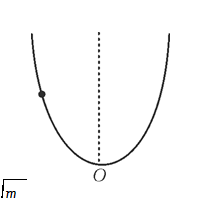A body of mass m is situated in potential field U(x)=Uo(1−cos∝x) where, Uo and ∝ are constants. Find the time period of small oscillations.
To find the time period of small oscillations for a body of mass m situated in the potential field U(x)=U0(1−cos(prop⋅x)), we can follow these steps:
Step 1: Identify the Potential Energy Function
The potential energy function is given as:
U(x)=U0(1−cos(prop⋅x))
Step 2: Calculate the Force
The force F acting on the mass can be derived from the potential energy using the relation:
F=−dUdx
We need to differentiate U(x) with respect to x:
dUdx=U0⋅ddx(1−cos(prop⋅x))=U0⋅sin(prop⋅x)⋅prop
Thus, the force becomes:
F=−U0⋅prop⋅sin(prop⋅x)
Step 3: Approximate for Small Oscillations
For small oscillations, we can use the approximation sin(θ)≈θ when θ is small. Therefore, we can write:
F≈−U0⋅prop⋅(prop⋅x)=−U0⋅prop2⋅x
Step 4: Relate Force to Simple Harmonic Motion
In simple harmonic motion, the force can also be expressed as:
F=−mω2x
where ω is the angular frequency. By equating the two expressions for force, we have:
−mω2x=−U0⋅prop2⋅x
Cancelling x (assuming x≠0):
mω2=U0⋅prop2
Step 5: Solve for Angular Frequency
From the above equation, we can solve for ω2:
ω2=U0⋅prop2m
Taking the square root gives:
ω=√U0⋅prop2m
Step 6: Find the Time Period
The time period T of the oscillation is related to the angular frequency by:
T=2πω
Substituting the expression for ω:
T=2π√mU0⋅prop2
Final Answer
Thus, the time period of small oscillations is given by:
T=2π√mU0⋅prop2
The potential energy function is given as:
U(x)=U0(1−cos(prop⋅x))
The force F acting on the mass can be derived from the potential energy using the relation:
F=−dUdx
We need to differentiate U(x) with respect to x:
dUdx=U0⋅ddx(1−cos(prop⋅x))=U0⋅sin(prop⋅x)⋅prop
Thus, the force becomes:
F=−U0⋅prop⋅sin(prop⋅x)
For small oscillations, we can use the approximation sin(θ)≈θ when θ is small. Therefore, we can write:
F≈−U0⋅prop⋅(prop⋅x)=−U0⋅prop2⋅x
In simple harmonic motion, the force can also be expressed as:
F=−mω2x
where ω is the angular frequency. By equating the two expressions for force, we have:
−mω2x=−U0⋅prop2⋅x
Cancelling x (assuming x≠0):
mω2=U0⋅prop2
From the above equation, we can solve for ω2:
ω2=U0⋅prop2m
Taking the square root gives:
ω=√U0⋅prop2m
The time period T of the oscillation is related to the angular frequency by:
T=2πω
Substituting the expression for ω:
T=2π√mU0⋅prop2
Thus, the time period of small oscillations is given by:
T=2π√mU0⋅prop2
Topper's Solved these Questions
- MOTION IN A STRAIGHT LINE BOOK - NCERT EXEMPLAR ENGLISHCHAPTER - MOTION IN A STRAIGHT LINE EXERCISE - Very Short Answer Type Qns
14 Videos
- SYSTEM OF PARTICLES AND ROTATIONAL MOTION BOOK - NCERT EXEMPLAR ENGLISHCHAPTER - SYSTEM OF PARTICLES AND ROTATIONAL MOTION EXERCISE - Long answer type questions
12 Videos
Similar Questions
The time period of small oscillations of mass m :-
_S01_040_Q01.png)
View SolutionThe potential energy of a particle of mass 'm' situated in a unidimensional potential field varies as U(x)=U0[1−cos(ax2)], where U0 and a are positive constant. The time period of small oscillations of the particle about the mean position-
View Solution
Knowledge Check
A body of mass m is situated in a potential field U(x)=U0(1−cosαx) when U0 and α are constant. Find the time period of small oscialltions.
A2π√mU0αB2π√mU0α2C2π√m2U0αD2π√2mU0α2
A partical of mass m is located in a unidimensionnal potential field where potentical energy of the partical depends on the coordinates xas:U(x)=U0(1−cosAx),U0 and A constants.
Find the period of small oscillation that the partical performs about the equilibrium position.
View SolutionA partical of mass m is located in a unidimensionnal potential field where potentical energy of the partical depends on the coordinates xasU(x)=Ax2−Bx where A and B are positive constant.
Find the time period of small oscillation that the partical perform about equilibrium possition.
View SolutionA particle of mass m in a unidirectional potential field have potential energy U(x)=α+2βx2, where α and β are positive constants. Find its time period of oscillations.
View SolutionA particle of mass m moves in a one dimensional potential energy U(x)=−ax2+bx4, where a and b are positive constant. The angular frequency of small oscillation about the minima of the potential energy is equal to
View SolutionA particle of mass m is moving in a potential well, for which the potential energy is given by U(x)=U0(1−cosax) where U0 and a are positive constants. Then (for the small value of x)
View SolutionA bead of mass m slides down a frictionless thin fixed wire held on the vertical plane and then performs small oscillations at the lowest point O of the wire. The wire takes the shape of a parabola near O and potential energy is given by U (x)=cx2, where c is a constant. The period of the small oscillations will be :

View SolutionThe potential energy of a particle in motion along X axis is given by U=U0−u0 cos ax. The time period of small oscillation is
View Solution
